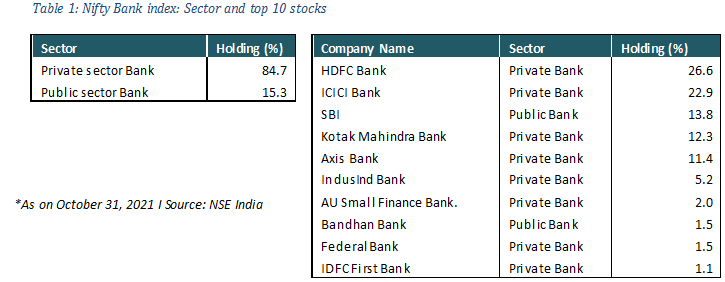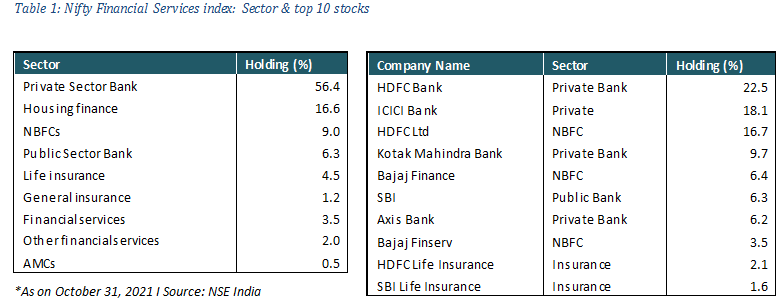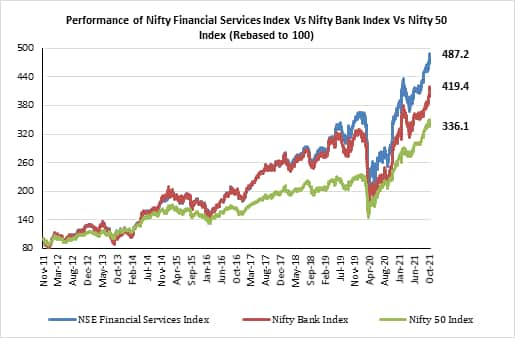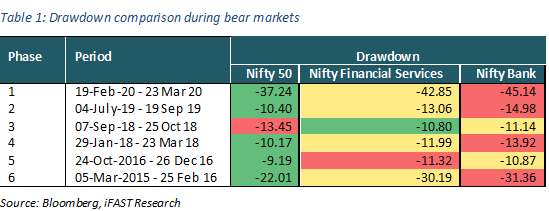Representative image
India’s Banking and Financial Service (BFSI) sector offers tremendous growth opportunities. Low credit to GDP ratios, increasing financialization of household savings, the government’s thrust on financial inclusion, and the industry’s focus on higher adoption of technology augur well for the sector.
Nifty Bank index and Nifty Financial Services index track this sector, offering investors an easy and cost-effective way to invest in this high-conviction space. While the Nifty Bank index represents the most liquid and well capitalised public and private sector banks, the Nifty Financial Services represents the wider universe of financial services providers as well as banks. Currently, the NSE lists over 15 ETFs and 1 index fund within the thematic passive category across both indices.
In this article, we look at three key parameters to help you choose the strategy that works best for you.
Diversification & stock concentration
The Nifty Bank index is a pure bank-only index comprising large Indian public and private sector bank stocks. The Nifty Financial Services index is broader and includes stocks of banks, non-banking financial companies (NBFCs), housing finance companies, insurance companies and others. The Nifty Financial Services index comprises 20 stocks, while the Nifty Bank Index includes only 12.


Long term performance
Over the last ten years, both Nifty Financial Services and Nifty Bank have outperformed the Nifty 50 index. This has been reflected in the rising share of banks and financial services in the overall market capitalisation in India.
The broader financial services sector has started differentiating itself from banking in the last three years, and we see consistent outperformance of the Nifty Financial Services index over Nifty Bank in this time.
Figure 1: Nifty 50 v/s Nifty Bank v/s Nifty Financial Services

Even when compared on the basis of yearly performance or absolute performance over the long term, the Nifty Financial Services index has convincingly outperformed the Nifty Bank index and Nifty 50 index in a majority of instances.

Volatility and drawdowns
Being concentrated in nature, both the Nifty Bank and Nifty Financial Services indices are more volatile than the broader market index, Nifty 50. However, the Nifty Bank index is relatively more volatile with a standard deviation of 1.55 (Figure 2) since it includes only pure banking stocks, which are more vulnerable to business cycles and may see volatility during economic downturns. The Nifty Financial Services index is has slightly lesser standard deviation at 1.46.
Figure 2: Volatility of Nifty Financial Services & Nifty Bank v/s Nifty 50

Their volatility is also reflected in the higher drawdowns experienced by the Nifty Bank and Nifty Financial Services indices in most of the bear market cycles as compared to Nifty 50 (Table 4). Out of six bear market instances, Nifty Bank has the highest drawdowns in four, with Nifty Financial Services faring marginally better.

Our View
We believe that India’s broader financial services sector stands to gain from an uptick in financial performances and loan books for high-quality banks and select NBFCs. Other tailwinds include growth in the insurance sector, increasing retail participation in the capital market-linked businesses, and massive focus on digitalization in the financial space.
The Nifty Financial Services index and therefore index funds and ETFs benchmarked to it are likely to outperform the Nifty Bank index given the immense headroom for growth of financial services and products in India. Investors who prefer benefits of steady compounding of returns over the long haul can include it as a part of their tactical portfolio.
On the other hand, the core banking sector represents a more concentrated opportunity, with some near-term tailwinds in its favour. Indian banks have overcome multiple factors like weak credit growth and rise in provisioning cost and are now undergoing a consolidation space. Going ahead, factors such as capex revival, improvement in credit growth, and government policies bode well for this sector. Large private banks with strong capital position, granular liability franchise, diversified asset base and higher digital adoption are especially well-positioned to capitalise on the capex revival cycle.
With the ongoing consolidation and fundamental factors in play, the Nifty Bank index based passive funds and ETFs are likely to do well over the short to medium term, and can be considered as a tactical opportunity by investors who can handle the volatility of concentrated exposure.